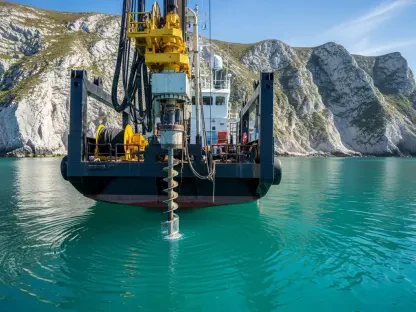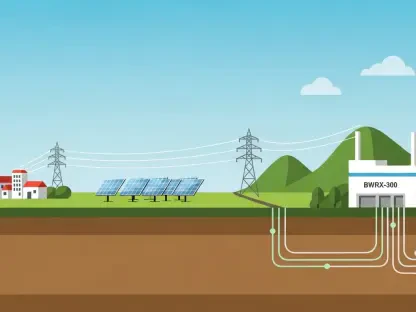What does it mean when a global investment titan like KKR considers unloading a staggering $7 billion stake in a critical energy asset? In the high-stakes world of energy infrastructure, where stability meets soaring demand, such a move reverberates across markets and boardrooms alike. Picture this: a single transaction that could reshape the landscape of Canadian energy investments, spotlighting Pembina Gas Infrastructure as a linchpin in western Canada’s resource-rich regions. This is not just a deal; it’s a signal of shifting strategies and untapped opportunities waiting to be seized.
The significance of this potential sale lies in its scale and timing. With energy needs escalating globally, infrastructure assets like Pembina Gas Infrastructure—capable of processing 5 billion cubic feet of natural gas daily—stand as pillars of reliability and growth. KKR’s exploration of divesting its 40% stake underscores a broader trend of capitalizing on favorable market conditions, drawing attention from alternative asset managers and infrastructure funds eager for steady returns. This story unfolds as a critical chapter in the evolving narrative of energy investments, where every decision could redefine portfolios and influence industry dynamics.
A Strategic Pivot in the Energy Sector
KKR, a heavyweight in global investments, has turned heads by weighing the sale of its substantial share in Pembina Gas Infrastructure. This isn’t a minor reshuffle but a potential $7 billion transaction that highlights the firm’s knack for timing exits amid peak market interest. Based in western Canada, the joint venture with Pembina Pipeline Corp. has grown into a powerhouse, managing vital natural gas and liquids transportation and storage since its inception.
The deal’s magnitude reflects more than just numbers; it’s a testament to the confidence in Canadian energy assets as cornerstones of global supply chains. Scotiabank’s involvement in assessing buyer interest further signals a structured approach to this blockbuster opportunity. While no agreement is finalized, the buzz around this move suggests a calculated strategy to leverage current demand, positioning KKR to potentially reap significant gains from an asset that has expanded through strategic projects and acquisitions.
The Allure of Canadian Energy Infrastructure
Canada’s energy sector is riding a wave of heightened activity, driven by an insatiable global appetite for dependable infrastructure. Assets tied to regions like the Montney and Duvernay shale formations are particularly coveted for their capacity to support long-term growth. Pembina Gas Infrastructure, processing billions of cubic feet of natural gas daily, epitomizes the kind of midstream operation that promises consistent returns amid market volatility.
This appeal isn’t lost on investors seeking stability over speculative gains. The scarcity of large-scale pipeline opportunities in Canada adds a premium to such stakes, making them rare prizes for funds looking to diversify without the burden of operational complexity. As consolidation sweeps through the sector, the timing of this potential sale aligns with a broader push to scale up and meet escalating energy demands, painting a vivid picture of an industry at a crossroads.
Unpacking the Financial Layers of the Deal
At the heart of this transaction is a 40% stake initially valued within a venture worth about $8.17 billion USD, now estimated at a striking $7 billion. This appreciation speaks to Pembina Gas Infrastructure’s robust growth through new initiatives and asset integrations over recent years. The figure alone underscores how strategic expansions can elevate an investment’s worth in a competitive landscape.
Market dynamics add another layer of intrigue, with the rarity of such Canadian assets driving up their allure among infrastructure funds and alternative asset managers. These investors are drawn by the prospect of predictable revenue without the need for hands-on management. With Scotiabank facilitating outreach to potential buyers, the process reflects strong confidence in the sector, though the absence of a guaranteed deal keeps speculation alive about who might ultimately claim this prized stake.
Market Buzz and Expert Takes
Industry insiders have noted the lucrative potential of KKR’s possible exit, especially given the asset’s expansion and the market’s hunger for midstream opportunities. While anonymity shields direct statements, the sentiment is clear: a $7 billion valuation for this stake represents a significant return on investment, fueled by the venture’s enhanced capacity and strategic positioning in key shale regions.
Analysts have pointed to the “unique scarcity value” of large Canadian energy stakes as a driving factor in their attractiveness. This perspective highlights why such deals draw intense interest, with midstream assets offering a balance of low operational risk and reliable income streams. The consensus suggests a seller’s market, where timing and asset quality could yield exceptional outcomes for those ready to act.
What Lies Ahead for Investors and Stakeholders
For those tracking energy infrastructure or considering entry into this space, KKR’s potential move offers critical insights. Keeping a close eye on buyer interest and competitor strategies in Canadian energy markets can reveal emerging opportunities. Updates on this deal could serve as a barometer for broader investment trends, signaling whether now is the moment to engage or hold back.
Stability remains a key consideration—assets like Pembina Gas Infrastructure, with their blend of steady returns and growth potential, deserve priority in diversified portfolios. Timing also matters; the current market fervor suggests a window for strategic buying or selling, especially as valuations peak. Staying agile and informed will be essential as deals of this scale have the power to transform investment landscapes in an instant.
Reflecting on a Monumental Shift
Looking back, KKR’s exploration of a $7 billion stake sale in Pembina Gas Infrastructure stood as a defining moment in the energy investment arena. It highlighted the immense value embedded in Canadian midstream assets and the strategic foresight required to navigate such high-stakes transactions. The market’s response underscored a collective recognition of infrastructure as a bedrock of global energy needs.
For stakeholders and investors, the next steps involved deeper analysis of similar opportunities, focusing on assets that mirrored this balance of reliability and growth. Engaging with industry updates and aligning portfolios with emerging trends became crucial actions following this pivotal development. Beyond the numbers, this episode served as a reminder of the power of timing and positioning in shaping the future of energy investments.









